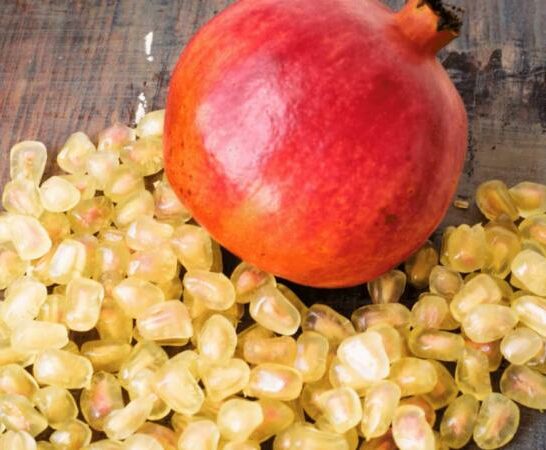Do you regularly eat pomegranates?
These fruits are full of vitamins and nutrients that contribute to a wide range of health benefits, from improved brain health to reduced inflammation.
Did you know that there are different colors of pomegranates, and hence, different colors of seeds- or arils- inside? There are- and here is what you should know!
Why are My Pomegranate Seeds White?
Pomegranate Seeds are white because of the variety of pomegranate and the conditions the fruits grow in. Some pomegranates produce light pink or even white seeds. Some may change color from one grow season to the next. Whether the seeds are deep red or pale white, they still have the same flavor and delicious juice that is associated with this fruit. Some say white pom seeds are sweeter and less acidic, too.
White Pomegranate Seeds
Have you ever eaten white pomegranate seeds or arils?
The white seeds are usually sweeter than other pom arils- or seeds.
They also are somewhat softer and less tough of a fruit than traditional red pomegranates.
Whether choosing white or red, pink or blush pomegranates, the flavors are very similar and all offer the same amazing health benefits!
White pom seeds also have less acidity than other varieties of pomegranate seeds. That may be why the texture is slightly different, softer, and the taste seems much sweeter. The acidity in red pomegranates manifests in a slightly more tart fruit and juice.
You know that you can eat the entire seed, right?
The seed is also called an aril and it is full of delicious pom juice- as well as a tiny, crunchy seed.
These seed bits are full of fiber and provide a satisfying crunch for snacking or when tossed in a salad.
How will you know if your pomegranate has turned bad or spoiled?
You should avoid eating a pomegranate that smells sour, off, or rotten when you sniff it. If the inside of your fruit is brown or browning, discard it right away.
This is a sign that it has gone bad.
Also, a bad pomegranate will have soft, mushy seeds inside, instead of the firm, juicy arils that you expect to find.
Selecting and Storing a Pomegranate
Regardless of the color of pomegranate, you are shopping for, you want to look for firm fruit that are hefty for the size that they are.
Do not focus solely on the color of the pomegranate, but rather look for a sturdy fruit that feels heavy when you hold it.
The bigger the fruit you choose, the likely it is to be juicy- so look for a big pomegranate when choosing one to buy.
Avoid fruit with cracks or bruises as these are going to spoil a lot faster if they already have not.
Keep your poms on the kitchen counter at room temperature for up to a week, or in the refrigerator for up to two weeks.
If you remove the fruit’s seeds, you can store the seeds in the fridge for a week in an airtight container, or for up to three months if frozen.
Health Advantages of Pomegranates
You have probably heard the compelling evidence of the health benefits that pomegranates provide.
Whether you choose red poms or white, pink arils, or deep red, here are just a few of the health perks provided by pomegranates.
- Eating pomegranates may provide the fuel you need to get through rigorous exercise or a workout. These fruits help to open up blood vessels and improve blood flow.
- The nutrients in pomegranates may help reduce symptoms of PMS by modulating the effects of estrogen in the body. This can help to regulate some women’s menstrual cycles.
- Pomegranates contain feel-good nutrients that support mental health and wellbeing.
- Pomegranates may help improve memory and concentration.
- Pomegranates are an excellent source of antioxidants that can reduce inflammation and fight certain diseases.
Remember that both white and red varieties offer health advantages.
If you prefer sweeter poms, opt for white varieties. If you prefer a more tart aril, red poms may be your preference.
Frequently Asked Questions About Pomegranate
What does a White Pomegranate taste like?
White pomegranates have the highest sugar content of pomegranates, so they often taste sweeter than other varieties. The texture of the white pomegranate is softer, too, and the fruit is less acidic.
Why are some pomegranates red inside?
The type of pomegranate commands whether it will be red or white inside. There are many different kinds that yield different colored fruit and arils.
Is it normal for pomegranate seeds to be pink?
It is normal for some pomegranates to yield pink seeds, or arils. It is also normal or common for pomegranates to have red or white seeds, as well. It depends on the variety and the growing conditions.
What are the health benefits of white pomegranates?
White pomegranates are high in vitamins B and C as well as antioxidants, potassium, protein, carbohydrates, and fiber, too.
Conclusion
Do you eat pomegranates?
You should- they are full of vitamins and nutrients that contribute to holistic health and wellbeing.
If your pomegranate has white seeds, don’t worry- there are certain varieties that feature red, light pink, and, yes, white seeds, or arils.
These arils are full of juice and fiber so eat and enjoy!

